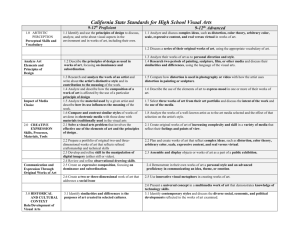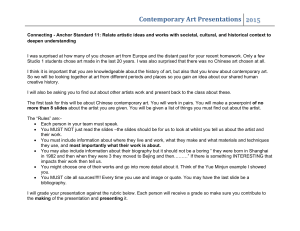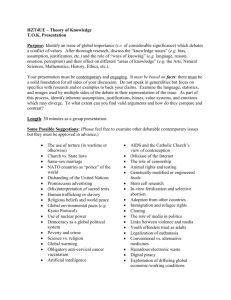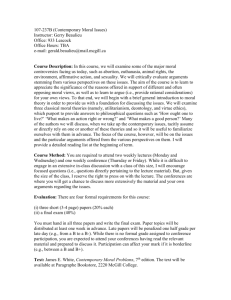doc - PIIPA
advertisement
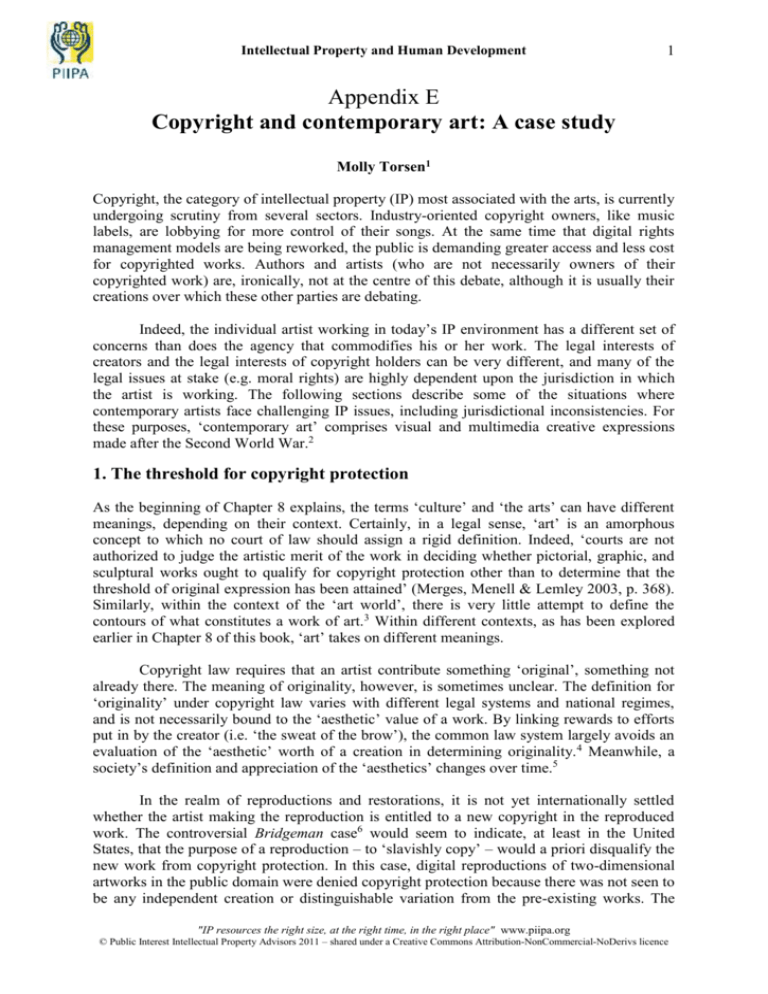
Intellectual Property and Human Development 1 Appendix E Copyright and contemporary art: A case study Molly Torsen1 Copyright, the category of intellectual property (IP) most associated with the arts, is currently undergoing scrutiny from several sectors. Industry-oriented copyright owners, like music labels, are lobbying for more control of their songs. At the same time that digital rights management models are being reworked, the public is demanding greater access and less cost for copyrighted works. Authors and artists (who are not necessarily owners of their copyrighted work) are, ironically, not at the centre of this debate, although it is usually their creations over which these other parties are debating. Indeed, the individual artist working in today’s IP environment has a different set of concerns than does the agency that commodifies his or her work. The legal interests of creators and the legal interests of copyright holders can be very different, and many of the legal issues at stake (e.g. moral rights) are highly dependent upon the jurisdiction in which the artist is working. The following sections describe some of the situations where contemporary artists face challenging IP issues, including jurisdictional inconsistencies. For these purposes, ‘contemporary art’ comprises visual and multimedia creative expressions made after the Second World War.2 1. The threshold for copyright protection As the beginning of Chapter 8 explains, the terms ‘culture’ and ‘the arts’ can have different meanings, depending on their context. Certainly, in a legal sense, ‘art’ is an amorphous concept to which no court of law should assign a rigid definition. Indeed, ‘courts are not authorized to judge the artistic merit of the work in deciding whether pictorial, graphic, and sculptural works ought to qualify for copyright protection other than to determine that the threshold of original expression has been attained’ (Merges, Menell & Lemley 2003, p. 368). Similarly, within the context of the ‘art world’, there is very little attempt to define the contours of what constitutes a work of art.3 Within different contexts, as has been explored earlier in Chapter 8 of this book, ‘art’ takes on different meanings. Copyright law requires that an artist contribute something ‘original’, something not already there. The meaning of originality, however, is sometimes unclear. The definition for ‘originality’ under copyright law varies with different legal systems and national regimes, and is not necessarily bound to the ‘aesthetic’ value of a work. By linking rewards to efforts put in by the creator (i.e. ‘the sweat of the brow’), the common law system largely avoids an evaluation of the ‘aesthetic’ worth of a creation in determining originality. 4 Meanwhile, a society’s definition and appreciation of the ‘aesthetics’ changes over time.5 In the realm of reproductions and restorations, it is not yet internationally settled whether the artist making the reproduction is entitled to a new copyright in the reproduced work. The controversial Bridgeman case6 would seem to indicate, at least in the United States, that the purpose of a reproduction – to ‘slavishly copy’ – would a priori disqualify the new work from copyright protection. In this case, digital reproductions of two-dimensional artworks in the public domain were denied copyright protection because there was not seen to be any independent creation or distinguishable variation from the pre-existing works. The "IP resources the right size, at the right time, in the right place" www.piipa.org © Public Interest Intellectual Property Advisors 2011 – shared under a Creative Commons Attribution-NonCommercial-NoDerivs licence Intellectual Property and Human Development 2 viability of an argument for originality remains unclear in other similar circumstances, such as the restorations of murals or buildings, in which a restorer arguably uses a great deal of judgment and creativity to make a new work based on but not identical to the original work. 2. The ideaexpression dichotomy Henry Lydiate, Emeritus Professor of Art and Law, University of the Arts, London, has said: ‘No one knew anything of dadaism, Marcel Duchamp and conceptual art when the (UK) legislation was framed, and in contemporary art – where the idea is more important than the form – there is a lack of protection for ideas.’7 It is central to many jurisdictions’ copyright laws that it is the expression of an idea, rather than the idea itself, that receives copyright protection. For example, Amadeo Modigliani’s elongated and stylized portraits are protected under copyright only as they are embodied as individual paintings; his style is not copyrightable and, as such, other artists are free to paint elongated and stylized portraits so long as they do not exactly copy Modigliani’s work. Some contemporary artists are struggling with this distinction because they feel the root of their creation is not necessarily any particular manifestation of their idea; rather, it is the idea that they would like to claim as their own. One example where this issue is highlighted is in the work of Christo and JeanneClaude, until Jeanne-Claude’s passing in November 2009. They were an artistic duo who created installation art – art that uses a variety of media to modify the way people experience a given space. Some of the work they have done includes wrapping the Pont Neuf bridge in Paris, and creating a twenty-four-mile-long curtain in the Marin and Sonoma counties in California.8 They have created a similar ‘curtain’ in New York City’s Central Park. Under current US copyright law – and under most Western copyright laws – the ideaexpression dichotomy, which reserves copyright protection for delineated expressions of ideas, would solely prevent an exact replica of any of these works.9 If, however, another installation artist decided to wrap the Brooklyn Bridge in the same material Christo and Jeanne-Claude used to wrap the Pont Neuf, copyright law would not prevent it. 3. The fixation requirement Many jurisdictions, with some notable exceptions,10 require that a work be fixed in a tangible form of expression before copyright can inhere. As such, a sketch in the sand on a beach and an ink drawing on a human body will not achieve copyright status because the water will wash them away. While the requirement that a work be fixed has been debated and criticized (see Brennan & Christie 2000), it remains the international norm with the exception of some jurisdictions. This has presented at least a hypothetical problem for artists like Dan Harvey and Heather Ackroyd, two British artists who have been collaborating since 1990 and who use elements of living organisms in their work. Grass, for example, is incorporated into a work to communicate the artists’ exploration of transience, alchemy and decay. 11 Harvey and Ackroyd have won numerous awards for their work but the extent to which their work is copyrightable is debatable, at best. At no given moment is their work ‘fixed’, given that the growing grass (amongst other organic materials they employ) is constantly changing their art. This legal ‘rule’ can also be showcased with regard to a choreographed dance. The dance itself is only protected under copyright when it is ‘fixed’, either as a video (or some other tangible audiovisual rendering) of the dance or as a write-up of its choreographic parts. "IP resources the right size, at the right time, in the right place" www.piipa.org © Public Interest Intellectual Property Advisors 2011 – shared under a Creative Commons Attribution-NonCommercial-NoDerivs licence Intellectual Property and Human Development 3 4. Copyright exceptions and appropriation art Copyright exceptions – including ‘fair dealing’ and ‘fair use’ in common law jurisdictions – take on an important role in the realm of contemporary art, especially with regard to appropriation art. Appropriation art, another category of art that is difficult to define with precision, generally addresses art that ‘borrows common images from advertising, the mass media and elsewhere, places them in new contexts and, thereby, aims to change the way we think about these images’ (Landes 1999). ‘Appropriation (art) was developed…in the readymades created by the French artist Marcel Duchamp from 1915. Most notorious of these was Fountain, a men’s urinal signed, titled, and presented on a pedestal’.12 However, an example like Fountain does not necessarily present the copyright problems that can crop up with other examples of appropriation art because the creator of the original urinal was probably not interested in copyrighting it for artistic reasons. The same is not true with Jeff Koons’ art. Jeff Koons is a contemporary artist with a background both as a commodity broker on Wall Street and as a senior representative for a modern art museum.13 It has been said that ‘with his stated artistic intention to “communicate with the masses”, Koons draws from the visual language of advertising, marketing, and the entertainment industry’.14 Amongst other forms of art, Koons has ‘quoted’ various types of contemporary pop culture, including a postcard photograph of a series of puppies seated on the laps of two people in the Midwest (Koons created a life-size sculpture of that image) and an advertisement for silk Gucci sandals (Koons created an oil painting very similar to the Gucci advertisement). In the first scenario, the photographer of the original postcard sued Koons and won; the judge in that case15 found that an artist’s copy of a photograph could not be protected when there is no clear need to imitate that specific photograph for the sake of parody. Parody is a copyright exception in US law (see Chapter 8, Section 5.1) under which Koons argued his case. In the second (silk sandals) scenario, Koons won his case partly based on the judge’s opinion that Koons’ transformation of the original advertisement was substantial enough to differentiate between the two. Koons was, again, using the original artwork as visual fodder for his commentary on the consequences of popular media; yet, the outcomes of the cases were completely different. From an artistic or aesthetic perspective, the contours of fair use in these scenarios are difficult to understand and to predict. 5. Moral rights The influence of natural rights arguments for the protection of creative works as an extension or expression of the creator’s personality is particularly evident in moral rights protection. Fisher (2001, p. 174) observes: ‘The French and German [authors’ rights] regimes, for example, have been strongly shaped by the writings of Kant and Hegel. This influence is especially evident in the generous protection those countries provide for “moral rights” – authors’ and artists’ rights to control the public disclosure of their works, to withdraw their works from public circulation, to receive appropriate credit for their creations, and above all to protect their works against mutilation or destruction.’ While ‘natural rights’ arguments are often associated with civil law jurisdictions, they have had their influence as well on the evolution of common law copyright systems (see Afori 2004). The introduction of ‘moral rights’ to common law copyright systems through international harmonization means that arguments to protect the creator’s ‘personality’ are also at work today in those systems (Guibault 2002, p. 8). "IP resources the right size, at the right time, in the right place" www.piipa.org © Public Interest Intellectual Property Advisors 2011 – shared under a Creative Commons Attribution-NonCommercial-NoDerivs licence Intellectual Property and Human Development 4 Often debated even in the context of orthodox artistic media, moral rights laws are receiving renewed interest in the realm of contemporary art and digital media. In the context of contemporary art, moral rights can pose very interesting problems. In the international arena, moral rights law has not been heavily litigated and there is therefore a paucity of case law to inform artists of their rights (Adeney 2006, p. 627). For example, an artist whose work is best viewed in person may have granted a museum the right to reproduce her art in a largescale ‘coffee table’ book but she may take issue with her work being reproduced on the museum’s website if the image looks distorted to her. Depending on the jurisdiction of the museum and the language in any given copyright release contract, the artist may be able to argue that her moral rights entitle her to prevent her artwork from being reproduced on the Internet.16 Certainly, moral rights and appropriation art can also grate at each other. The right to attribution is often surpassed in the context of appropriation art, especially if the original image is so well-known that its iconic stature is the appropriation artist’s purpose for quoting it. Andy Warhol’s Marilyn Monroe was a piece of appropriation art, inspired by Gene Korman’s 1953 photograph of the actress. Today, Warhol’s painting is much better known than the original photograph but, at the time, Warhol was making an artistic comment that certainly quoted Korman’s work. The moral rights of Korman, as a photographer, did not make it to court; in the United States, moral rights are protected either through common law or through the very narrow Visual Artists Rights Act 17 which only took effect in 1990. Had Warhol worked in France, his work may have been suppressed or his work may have had to credit Korman in some way. These and other scenarios highlight some of the jurisdictional differences and overall uncertainties about moral rights in the modern era. 6. Multimedia works Another dimension to the IPcontemporary art nexus is that of the multimedia work, where many of the aforementioned issues occur simultaneously. Multimedia works may also have an audio component. Videos and other multimedia art can elicit an entirely new set of IP issues because they are protected quite differently from purely visual works. ‘Multimedia’ is another term whose semantics are undefined in the realm of the arts. It can include a range of works, including basic audio-visual works (like videos) and interactive, multidisciplinary works and complex installations. One example of a complex multimedia work is Pierre Huyghe’s Celebration Park, which features ‘objects, texts, architectural features and films, all orchestrated within [an] exhibition space to create a landscape of discovery’.18 Indeed, visitors to Huyghe’s work ‘experience a number of surprising apparitions, such as a set of gigantic doors which dance through the gallery’.19 The work includes puppet shows, natural history films and staged celebrations. It also includes a film showing an opera staged in Antarctica and New York City’s Central Park. Clearly, Celebration Park is a multifaceted work with a long list of copyrightable features. For an installation work that Huyghe exhibited at Harvard University, the school had to sign forty-five different contracts to install and exhibit it.20 While the scope of those contracts and the various rights at play are beyond the scope of this writing, it is representative of the sometimes difficult fit that copyright provides for artworks that can be broken down into several component copyrightable parts. "IP resources the right size, at the right time, in the right place" www.piipa.org © Public Interest Intellectual Property Advisors 2011 – shared under a Creative Commons Attribution-NonCommercial-NoDerivs licence Intellectual Property and Human Development 5 Notes 1 The references for this Appendix are found in the reference list for Chapter 8. The definition of ‘contemporary art’, as well as the definition of ‘art’, has been debated and discussed since at least the 1950s. See, for example, Hodin 1951. 3 See, for example, Christie’s – Fine Art Auction, ‘Glossary’, available at: http:www.christies.comglossaryauction_glossary.asp (accessed 12 February 2009). Individual artistic movements or styles are described (such as ‘Futurism’ and ‘Rococo’), but no overarching definition for terms such as ‘art’ or ‘contemporary art’ or ‘medieval art’ is attempted. 4 Bently (1994, p. 81) notes examples of US and UK case law which suggest that ‘there is no requirement that the work be of any artistic quality’. See further Ginsburg 1990. Ginsburg suggests that Anglo-American copyright law has historically protected not only works of creativity but also works of commercial value. 5 As pointed out by Prott (1998a, p. 164): ‘What is not valued as high Culture in one age may be seen as a peak achievement in another period by the same society’ (original capitalization by author). 6 Bridgeman Art Library, Ltd. v. Corel Corp., 25 F. Supp. 2d 421 (S.D.N.Y. 1998). 7 Wade A., ‘Can You Own an Idea?’, The Guardian, 6 May 2003, quoting Henry Lydiate. 8 For photographs of selected examples of their work, see Christo and Jeanne-Claude, The Vogel Collection at the National Gallery of Art, available at: http:www.nga.govexhibitions2002christointro.shtm (accessed 12 February 2009). 9 17 U.S.C. § 102(b): ‘In no case does copyright protection for an original work of authorship extend to any idea, procedure, process, system, method of operation, concept, principle, or discovery, regardless of the form in which it is described, explained, illustrated, or embodied in such work’. 10 Exceptions include Switzerland and several Latin American jurisdictions. 11 See Heather Ackroyd & Dan Harvey, Artsadmin UK, available at: http:www.artsadmin.co.ukprojectsartist.php?id40 (accessed 12 February 2009). 12 Patry, W., ‘The Patry Copyright Blog’, Appropriation Art and Copies, 20 October 2005. For an image of Fountain, see the San Francisco Museum of Modern Art, available at: http:www.sfmoma.orgmsomaartworks1466.html (accessed 15 June 2007). This replica of Fountain is glazed ceramic with black paint, purchased through a gift of Phyllis Watts. 13 Ottmann, K., Interview with Jeff Koons, Journal of Contemporary Art, October 1986. 14 Jeff Koons, Guggenheim Collection, available at: http:www.guggenheimcollection.orgsiteartist_work_md_P65.html (accessed 12 February 2009). 15 Rogers v. Koons, 960 F.2d 301 (2d Cir. 1992). 16 See Johnston, L., ‘Displaying Visual Art on the Internet’, ART + Law, June 2007, available at: http:www.artslaw.com.auArtLawCurrent07DisplayingVisualArtOnTheInternet.asp (accessed 1 June 2007). Johnston notes that: ‘For those reproducing visual art online it is important that they ensure the moral rights of the artist are kept intact. Respecting the creator’s moral rights involves crediting the artist (right to attribution), not crediting the artwork to someone who is not the artist (right against false attribution) and not using the artists’ work in a way which would damage their reputation (right of integrity)’. 17 17 U.S.C. § 106A. 18 Pierre Huyghe, Tate Modern, available at: http:www.tate.org.ukmodernexhibitionspierrehuyghe (accessed 12 February 2009). 19 Ibid. 20 Lufkin, M. 2005, ‘Why Harvard Had to Sign 45 Contracts to Install a Work by Pierre Huyghe’, The Art Newspaper, 6 January 2005. 2 "IP resources the right size, at the right time, in the right place" www.piipa.org © Public Interest Intellectual Property Advisors 2011 – shared under a Creative Commons Attribution-NonCommercial-NoDerivs licence

